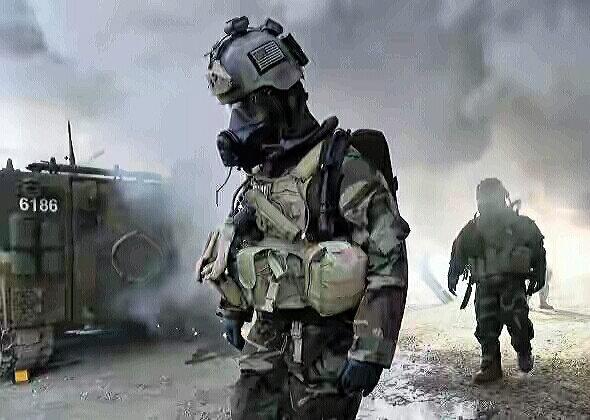Chemical warfareFor other uses, seeChemical warfare (disambiguation).Chemical warfare(CW) involves using thetoxic propertiesofchemical substancesas
weapons. This type of warfare is distinct fromnuclear warfareand
biological warfare, which together make up NBC, the military acronym for nuclear, biological, and chemical (warfare or weapons), all of which are considered "weapons of mass destruction" (WMDs). None of these fall under the termconventional weaponswhich are primarily effective due to their destructive potential. With proper protective equipment, training, and decontamination measures, the primary effects of chemical weapons can be overcome. Many nations possess vaststockpilesof weaponized agents in preparation for wartime use. The threat and the perceived threat have become strategic tools in planning both measures and counter-measures.DefinitionChemical warfare is different from the use ofconventional weaponsornuclear weaponsbecause thedestructive effects of chemical weapons are not primarily due to anyexplosiveforce. The offensive use of livingorganisms(such asanthrax) is consideredbiological warfarerather than chemical warfare; however, the use of nonliving toxic products produced by living organisms (e.g.toxinssuch asbotulinum toxin,ricin, andsaxitoxin)isconsidered chemical warfare under the provisions of theChemical Weapons Convention(CWC). Under this Convention, any toxic chemical, regardless of its origin, is considered a chemical weapon unless it is used for purposes that are not prohibited (an important legal definition known as theGeneral Purpose Criterion).[1]About 70 different chemicals have been used orstockpiledas chemical warfare agents during the 20th century. The entire class known asLethal Unitary Chemical Agents and Munitionshave been scheduled for elimination by the CWC.[2]Under the Convention, chemicals that are toxic enough to be used as chemical weapons, or that may be used to manufacture such chemicals, are divided into three groups according to their purpose and treatment:*.Schedule 1– Have few, if any, legitimate uses. These may only be produced or used for research, medical, pharmaceutical or protective purposes (i.e. testing of chemical weapons sensors and protective clothing). Examples includenerve agents,ricin,lewisiteandmustard gas. Any production over 100 g must be reported to theOPCWand a country can have a stockpile of no more than one tonne of these chemicals.*.Schedule 2– Have no large-scale industrial uses, but may have legitimate small-scale uses. Examples includedimethyl methylphosphonate, aprecursortosarinalso used as aflame retardant, andthiodiglycol, a precursor chemical used in the manufacture of mustard gas but also widely used as a solvent ininks.*.Schedule 3– Have legitimate large-scale industrial uses. Examples includephosgeneandchloropicrin. Both have been used as chemical weapons but phosgene is an important precursor in the manufacture of plastics and chloropicrin is used as a fumigant. The OPCW must be notified of, and may inspect, any plant producing more than 30 tonnes per year.HistoryAncient timesChemical weapons have been used for millennia in the form ofpoisoned spears and arrows, but evidence can be found for the existence of more advanced forms of chemical weapons in ancient and classical times.[clarification needed]Ancient Greek myths aboutHerculespoisoning his arrows with the venom of theHydramonster are the earliest references to toxic weapons in western literature. Homer's epics, theIliadand theOdyssey, allude to poisoned arrows used by both sides in the legendaryTrojan War(Bronze AgeGreece).[3]Some of the earliest surviving references to toxic warfare appear in theIndianepicsRamayanaandMahabharata.[4]The "Laws of Manu," a Hindu treatise on statecraft (c. 400 BC) forbids the use of poison and fire arrows, but advises poisoning food and water.Kautilya's "Arthashastra", a statecraft manual of the same era, contains hundreds of recipes for creating poison weapon
Comments


It can be difficult to write about this subject. I think you did a great job though! Thanks for this! branding agency san francisco
ReplyDeleteGreat post, you have pointed out some good details , I besides believe this s a very fantastic website. best branding agencies san francisco
ReplyDeleteHmm!! This blog is really cool, I’m web agency so lucky that I have reached here and got this awesome information.
ReplyDelete
ReplyDeleteThanks for sharing this information with us
Bulk Hand Sanitizer in Hyderabad . Dwibhashi’s Herbal Hand Sanitizer is the best Hand sanitizer In the Market. Dwibhashi’s Herbal Hand Sanitizer is purely Ayurvedic Hand Sanitizer. It sanitizes your hands and destroys germs and pathogens. One can regularly use this Hand Sanitizer.
Best Hand Sanitizer in Hyderabad . | Hand Sanitizer in Hyderabad .
This is really good to hear. thanks for the update and good luck. cricket umpire
ReplyDelete